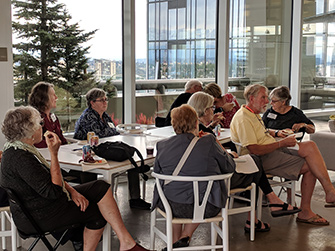Guiding Grandchildren to Positive Social Behavior

Jan Faull facilitated a PEPS for Grandparents Happy Hour, in addition to lively discussion and engagement with grandparents, she shared these tips on how grandparents can guide children to positive behavior. Join us at our next event!
Grandparenting Events
PEPS Benefit Luncheon
PEPS for Grandparents - Events & More
by Jan Faull, M.Ed., Parent Educator, retired
Be sure to uphold the parents’ approach to discipline. Nevertheless, you can develop your own rules when grandkids are at your house or with you.
Tell your grandchild what he is doing that’s right. Then request, move or guide her onto the next activity, “You climbed out of your car seat all by yourself. Good for you. Now it’s important to hold my hand in the parking lot.”
Use proximity control. If your grandchild is starting to become disruptive, quietly and gently move closer. Often your calm presence is enough to settle your grandchild.
Re-direct your grandchild. If your grandchild is touching something she’s not supposed to touch, show her what she can touch. If your grandchild is jumping of the sofa, show her where she can jump.
Remove an object. If your grandchild is coloring on the wall, remove the crayons. Another time demonstrate how and where to use crayons.
Lay out two realistic expectations. Before taking your grandchild into a new environment (e.g. a fancy restaurant, an airplane or a museum), present two age-appropriate expectations, “On the airplane it’s important to keep your seatbelt fastened and to whisper.”
Avoid difficult situations. If going to the grocery store causes problems, take a break from bringing your grandchild. A respite from taking him to the grocery store is often enough to give you and your grandchild the opportunity to start a new grocery store routine.
Avoid lots of change all at once. Avoid moving into a condo and getting a puppy the same month your second grandchild is being born. Doing so would be too much for you and your first grandchild to manage.
Remove your out-of-control grandchild. Take her from the scene of the misbehavior. Take him for a walk or go into another room; stay with the child until calm.
Provide the control your grandchild lacks. If you want your toddler to get down from the dining room table say, “I’m not going to allow you to stand on the table. Do you want to get down by yourself or do you want me to get you down?” You provide the control your grandchild lacks. In time that control transfer from you to your child.
Give clear commands and demonstrate. Rather than saying, “Put the toys away,” it’s more effective to say, “Put the truck in the box. I’ll put one in; I bet you can do that too. I’ll watch you.”
Look to the next event. “We had fun playing at the park today. In 5 minutes we’re going to get in the car, drive by the fire station and go to the grocery store.”
Offer a choice in a “no choice” situation. “You must sit in your car seat. Do you want to look at a book or hold your blanket?”
Establish rules. Work to establish one or two reasonable rules at a time, and then refer to them. “At Grandpa’s house we all sit at the dinner table for ten minutes.” “What’s the dinner table rule?”
Give to grandchildren in fantasy what they can’t have in reality. “You wish you could have that whole plate of cookies. You wish you could eat as many as you like. I understand that but at Grandma’s house we all eat just one.”
Ease transitions. Help your grandchild make a transition from one activity or situation to another. For example, sing a “getting to the table” song each time your grandchildren come for a meal.
Surrender the moment. If your grandchild is out of sorts, sit near him. Play, talk, and be with your child. Don’t feel you always need a perfect solution to a difficult or unpleasant situation. Sometimes it’s best to just let a difficult moment pass.
Let your grandchild be in charge. Children need the opportunities to be the boss, especially when playing. Putting a child in charge of age-appropriate situations increases the likelihood she will comply with your requests.
Engage your grandchild’s imagination. Children have wonderful imaginations. Play into that imaginative world for compliance. If your grandchild is refusing to get dressed, slip a sock on your hand and say, “Mr. Sock says, ‘it’s time to get dressed.’”
When…, then… “When you put your dolls in their bed, then I will read you a story.” When you hang up your coat, then we can have a snack.” “When you clear the table, then you can have screen time.”
Use your attention wisely. Children continue to behave in ways they are given attention. Children need attention. Be sure to give most of it for the positive and productive behavior they exhibit. “I see you putting the markers away. Thanks.”
Employ the one minute rule. When calling your grandchild to the table or instructing him to put on his coat, give one minute for the child to respond.
Give one word reminders. If your child enters your home and drops her coat on the floor as she heads for the toy box, sometimes all you need to say is “coat” as a reminder to hang up her coat.
About The Author
 Jan Faull, M.Ed., has taught Parent Education for more than twenty-seven years. Jan's weekly column Parenting for The Seattle Times ran for ten years.
Jan Faull, M.Ed., has taught Parent Education for more than twenty-seven years. Jan's weekly column Parenting for The Seattle Times ran for ten years.
She is a recognized speaker to a wide variety of local and national organizations. Jan is the author of five books: Mommy, I Have to Go Potty (Raefield & Roberts, 1996); Unplugging Parent-Child Power Struggles: Resolving Emotional Battles with Your Kids Ages 2-10 (Parenting Press, 2000); Darn Good Advice-Parenting (Barrons, 2005); and Darn Good Advice-Baby(Barrons, 2005). Her latest book: Amazing Minds: The Science of Nurturing Your Child's Developing Mind was published in August 2010 by Berkley Books a subsidiary of Penguin.
Jan was a board member for PEPS (Program for Early Parent Support) and currently serves on the PEPS Advisory Board. The mother of three adults and grandmother to three granddaughters, Emilia, Flora and Violet and one grandson, George, she resides in Seattle.
Document Actions